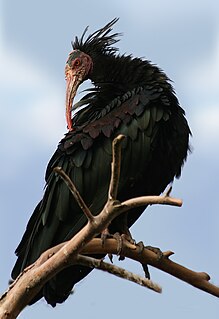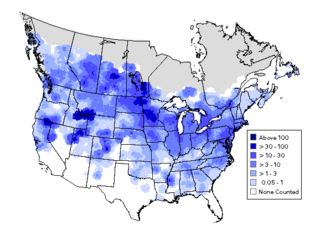
The pink-footed goose is a goose which breeds in eastern Greenland, Iceland and Svalbard. It is migratory, wintering in northwest Europe, especially Ireland, Great Britain, the Netherlands, and western Denmark. The name is often abbreviated in colloquial usage to "pinkfoot". Anser is the Latin for "goose", and brachyrhynchus comes from the ancient Greek brachus "short" and rhunchos "bill".

Bird migration is the regular seasonal movement, often north and south along a flyway, between breeding and wintering grounds. Many species of bird migrate. Migration carries high costs in predation and mortality, including from hunting by humans, and is driven primarily by availability of food. It occurs mainly in the northern hemisphere, where birds are funneled on to specific routes by natural barriers such as the Mediterranean Sea or the Caribbean Sea.

The northern bald ibis, hermit ibis, or waldrapp is a migratory bird found in barren, semi-desert or rocky habitats, often close to running water. This 70–80 cm (28–31 in) glossy black ibis, which, unlike many members of the ibis family, is non-wading, has an unfeathered red face and head, and a long, curved red bill. It breeds colonially on coastal or mountain cliff ledges, where it typically lays two to three eggs in a stick nest, and feeds on lizards, insects, and other small animals.

The Eurasian woodcock is a medium-small wading bird found in temperate and subarctic Eurasia. It has cryptic camouflage to suit its woodland habitat, with reddish-brown upperparts and buff-coloured underparts. Its eyes are set far back on its head to give it 360-degree vision and it probes in the ground for food with its long, sensitive bill, making it vulnerable to cold weather when the ground remains frozen.

The northern hawk-owl or northern hawk owl is a medium-sized true owl of the northern latitudes. It is non-migratory and usually stays within its breeding range, though it sometimes irrupts southward. It is one of the few owls that is neither nocturnal nor crepuscular, being active only during the day. This is the only living species in the genus Surnia of the family Strigidae, the "typical" owls. The species is sometimes called simply the hawk owl; however, many species of owls in the genus Ninox are also called "hawk owls".

The curlew sandpiper is a small wader that breeds on the tundra of Arctic Siberia. The genus name is from Ancient Greek kalidris or skalidris, a term used by Aristotle for some grey-coloured waterside birds. The specific ferruginea is from Latin ferrugo, ferruginis, "iron rust" referring to its colour in breeding plumage.

The British Trust for Ornithology (BTO) is an organisation founded in 1932 for the study of birds in the British Isles. The Duke of Cambridge has been patron since October 2020.

The brown creeper, also known as the American treecreeper, is a small songbird, the only North American member of the treecreeper family Certhiidae.

The trumpeter swan is a species of swan found in North America. The heaviest living bird native to North America, it is also the largest extant species of waterfowl, with a wingspan of 185 to 250 cm. It is the American counterpart and a close relative of the whooper swan of Eurasia, and even has been considered the same species by some authorities. By 1933, fewer than 70 wild trumpeters were known to exist, and extinction seemed imminent, until aerial surveys discovered a Pacific population of several thousand trumpeters around Alaska's Copper River. Careful reintroductions by wildlife agencies and the Trumpeter Swan Society gradually restored the North American wild population to over 46,000 birds by 2010.

Mist nets are used by ornithologists and bat biologists to capture wild birds and bats for banding or other research projects. Mist nets are typically made of nylon or polyester mesh suspended between two poles, resembling a volleyball net. When properly deployed in the correct habitat, the nets are virtually invisible. Mist nets have shelves created by horizontally strung lines that create a loose, baggy pocket. When a bird or bat hits the net, it falls into this pocket, where it becomes tangled.
The Tucson Bird Count (TBC) is a community-based program that monitors bird populations in and around the Tucson, Arizona, United States metropolitan area. With nearly 1000 sites monitored annually, the Tucson Bird Count is among the largest urban biological monitoring programs in the world.

The flesh-footed shearwater is a medium-sized shearwater. Its plumage is black. It has pale pinkish feet, and a pale bill with a distinct black tip. Together with the equally light-billed pink-footed shearwater, it forms the Hemipuffinus group, a superspecies which may or may not have an Atlantic relative in the great shearwater. These large shearwaters are among those that have been separated into the genus Ardenna. Recent genetic analysis indicates evidence of strong divergence between Pacific colonies relative to those in South and Western Australia, thought to be explained by philopatry and differences in foraging strategies during the breeding season.
There are many field methods available for conducting avian ecological research. They can be divided into three types: counts, nest monitoring, and capturing and marking.

The EBCC Atlas of European Breeding Birds - their distribution and abundance (ISBN 0-85661-091-7) is an ornithological atlas published for the European Bird Census Council by T & A D Poyser in 1997. Its editors were Ward J. M. Hagemeijer and Michael J. Blair. The atlas was the first to present grid-square distribution maps for all breeding birds at a Europe-wide level. The bulk of the book is in English, although it also contains introductions in thirteen other European languages. The atlas presents the results of the European Bird Census Council's European Ornithological Atlas project, the fieldwork for which was carried out between 1985 and 1988.
The Institute for Bird Populations (IBP), based in Petaluma, California, is a non-profit organization dedicated to studying and monitoring bird populations, and providing land managers and policy makers with information needed to better manage those populations.

A bird atlas is an ornithological work that attempts to provide information on the distribution, abundance, long-term change as well as seasonal patterns of bird occurrence and make extensive use of maps. They often involve a large numbers of volunteers to cover a wide geographic area and the methods used are standardized so that the studies can be continued in the future and the results remain comparable. In some cases the species covered may be restricted to those that breed or are resident. Migration atlases on the other hand cover migratory birds depict maps showing summaries of ringing and recoveries.

Chandler Seymour Robbins was an American ornithologist. His contributions to the field include co-authorship of an influential field guide to birds, as well as organizing the North American Breeding Bird Survey.
The Common Bird Monitoring Program is a citizen science bird monitoring program of India. It is a pioneer project that aims to engage general public in the collection of baseline data on 18 common bird species. Data collected will be used to map species abundance and distribution throughout the Indian subcontinent.

The Black Duck Joint Venture is a conservation partnership established in 1989 to stabilize and restore the population of the American black duck. It consists of government and non-governmental agencies and organizations in Canada and the United States. Its geographical scope is the Canadian provinces of Ontario, Quebec, New Brunswick, Nova Scotia, Prince Edward Island, and Newfoundland and Labrador, and the 23 U.S. states in the Atlantic and Mississippi Flyways. It was the first of the three species joint ventures operating within the North American Waterfowl Management Plan to be established.

A butterfly count is an event that is organized for the purpose of identifying and counting butterflies in a specific geographical area. Butterfly counts occur regularly in North America and Europe.
















